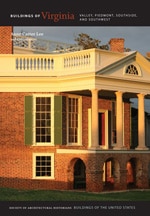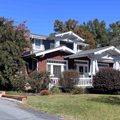Euclid Avenue is a broad tree-lined thorough-fare lined with large houses, many of which were built for Bristol's most prominent residents during the early twentieth century. The brick and frame house (1918) at 701 Euclid is influenced by the Arts and Crafts movement with its horizontal lines, deep eaves, wooden ornamentation in the gable, and broad shadowy porch carried on massive brick piers.
Clarence B. Kearfott designed the James Cecil House (c. 1920) at 619 Euclid. It is Mediterranean Revival with the symmetrical facade finished with stucco, a triple-arched loggia, and wide bracketed eaves. He also designed the Tudor Revival house (1926) for Colonel C. L. and Dixie Kidd at 411 Euclid with a rusticated stone first story, half-timbered second story, and a Tudor-arched porch. The work of Greene and Greene in California influenced the designer of the house (c. 1930) at 533 Euclid. This brick and frame house is a rising succession of shallow-pitched gables with deep eaves that emphasize horizontality. The portico and the gable above on the second story are carried on unusual clusters of three wooden piers, two angled and one straight. This tripartite theme is reflected in the first-story large windows flanked by double-sash windows and topped by long multi-light transoms.




































